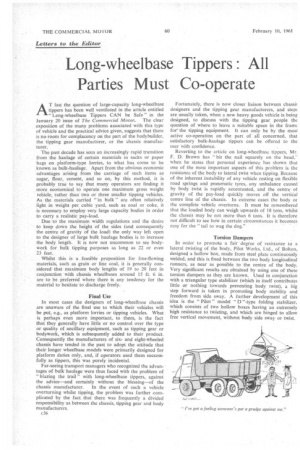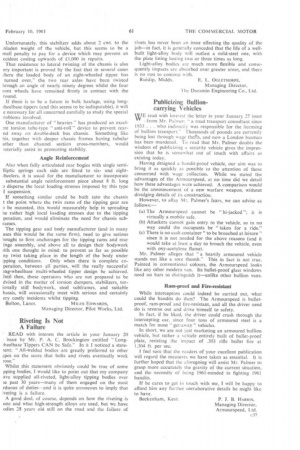Letters to the Editor
Page 74

Page 75

If you've noticed an error in this article please click here to report it so we can fix it.
Long-wheelbase Tippers : All Parties Must Co-operate
AT last the question of large-capacity long-wheelbase tippers has been well ventilated in the article entitled "Long-wheelbase Tippers CAN be Sate" in the January 20 issue of The Commercial Motor. The clear exposition of the many problems associated with this type of vehicle and the practical advice given, suggests that there is no room for complacency on the part of the bodybuilder, the tipping gear manufacturer, or the chassis manufacturer.
The past decade has seen an increasingly rapid transition from the haulage of certain materials in sacks or paper bags on platform-type lorries, to what has come to be known as bulk-haulage. Apart from the obvious economic advantages arising from the carriage of such items as sugar, flour, cement, and so on, by this method, it is probably true to say that many operators are finding it more economical to operate one maximum gross weight vehicle, rather than two or three smaller tipping vehicles. As the materials carried "in bulk" are often relatively light in weight per cubic yard, such as coal or coke, it is necessary to employ very large capacity bodies in order to carry a realistic pay-load.
Due to the maximum width regulations and the desire to keep down the height of the sides (and consequently the centre of gravity of the load) the only way left open to the designer of large bulk haulage bodies is to increase the body length. It is now not uncommon to see bodywork for bulk tipping purposes as long as 22 or even 23 feet.
Whilst this. is a feasible proposition for free-flowing materials, such as grain or fine coal, it is generally considered that maximum body lengths of 19 to 20 feet in conjunction with chassis wheelbases around 15 ft. 6 in. are to be preferred where there is any tendency for the material to hesitate to discharge freely,
Final Use
In most cases the designers of long-wheelbase chassis are unaware of the final use to which their vehicles will be put, e.g., as platform lorries or tipping vehicles. What is perhaps even more important, to them, is the fact that they generally have little or no control over the type or quality of ancillary equipment, such as tipping gear or bodywork, which is subsequently added to their product. Consequently the manufacturers of sixand eight-wheeled chassis have tended in the past to adopt the attitude that their longer wheelbase models were primarily designed for platform duties only, and, if operators used them successfully as tippers, this was purely incidental.
Far-seeing transport managers who recognized the advantages of bulk haulage were thus faced with the problem of "blazing the trail" with long-wheelbase tippers, against the advice—and certainly without the blessing—of the chassis manufacturer. In the event of such a vehicle overturning whilst tipping, the problem was further complicated by the fact that there was frequently a divided responsibility as between the chassis, tipping gear and body manufacturers. Fortunately, there is now closer liaison between chassis designers and the tipping gear manufacturers, and stem are usually taken, when a new heavy goods vehicle is being designed, to discuss with the tipping gear people the question of where to leave a suitable space in the frame foe the tipping equipment. It can only be by the mos1 active co-operation on the part of all concerned, that satisfactory bulk-haulage tippers can be offered to the user with confidence.
Reverting to the article on long-wheelbase tippers, Mr. F. D. Brown has "hit the nail squarely on the head,' when he states that personal experience has shown that one of the most important aspects of this problem is the resistance of the body to lateral twist when tipping. Because of the inherent instability of any vehicle resting on flexible road springs and pneumatic tyres, any unbalance caused by body twist is rapidly accentuated, and the centre ol gravity of the pay-load quickly moves off the vertical centre line of the chassis. In extreme cases the body or the complete, vehicle overturns. It must be remembered that the loaded body can weigh upwards of 18 tons, whilst the chassis may be not more than 6 tons. It is therefore not difficult to see how in certain circumstances it becomes easy for the "tail to wag the dog."
Torsion Dampers In order to promote a fair degree of resistance to a lateral twisting of the body, Pilot Works, Ltd., of Bolton, designed a hollow box, made from steel plate continuously welded, and this is fixed between the two body longitudinal runners, as near as possible to the centre of the body. Very significant results are obtained by using one of these torsion dampers as they are known. Used in conjunction with a triangular type stabilizer (which in itself contributes little or nothing towards preventing body twist), a big step forward is taken in promoting body stability and freedom from side sway. A further development of this idea is the " Pilot " model "D "-type folding stabilizer, which consists of two hollow boxes having an extremely high resistance to twisting, and which are hinged to allow free vertical movement, without body side sway or twist.
Unfortunately, this stabilizer adds about 2 cwt. to the nladen weight of the vehicle, but this seems to be a mall penalty to pay for a device which may prevent an ccident costing upwards of £1,000 in repairs.
That resistance to lateral twisting of the chassis is also cry important is proved by the fact that in several cases /here the loaded body of an eight-wheeled tipper has turned over," the two rear axles have been twisted hrough an angle of nearly ninety degrees whilst the four ront wheels have remained firmly in contact with the round.
If there is to be a future in bulk haulage, using longiheelbase tippers (and this seems to be indisputable), it will
e necessary for all concerned carefully to study the special ,roblems involved.
One manufacturer of " heavies " has produced an excelmt torsion tube-type " anti-roll " device to prevent rearnd sway on double-deck bus chassis. Something like his, together with deeper chassis frames having tubular ather than channel section cross-members, would -iaterially assist in promoting stability.
Angle Reinforcement
Also when fully articulated rear bogies with single semilliptic springs each side are fitted to sixand eight/heelers, it is usual for the manufacturer to incorporate substantial angle reinforcement piece about 8 ft. long a disperse the local loading stresses imposed by this type f suspension.
If something similar could be built into the chassis t the point where the twin rams of the tipping gear are 3 be mounted, this would measurably help in spreading he rather high local loading stresses due to the tipping peration, and would eliminate the need for chassis subraffles.
The tipping gear and body manufacturer (and in many ases this would be the same firm), need to give serious hought to firm anchorages for the tipping rams and rear inge assembly, and above all to design their bodywork /ith one thought in mind: to prevent as far as possible ny twist taking place in the length of the body under
pping conditions. Only when there is complete coperation, between all parties, will the really successful mg-wheelbase multi-wheeled tipper design be achieved, Jntil then, those operators who are not prepared to be dvised in the matter of torsion dampers, stabilizers, torionally stiff bodywork, steel subframes, and suitable hassis, will occasionally meet with serious and certainly cry costly incidents whilst tipping.
Bolton, Lancs. MILES EDWARDS, Managing Director, Pilot Works, Ltd.
Riveting Is Not A Failure
READ with interest the article in your January 20 issue by Mr. P. A. C. Brockington entitled " Longrheelbase Tippers CAN be Safe." In it I noticed a statelent: "All-welded bodies are greatly preferred to other epes on the score that bolts and rivets eventually work )ose."
Whilst this statement obviously could be true of some pping bodies, I would like to point out that my company ave supplied all-riveted, light-alloy tipping bodies over le past 30 years—many of them engaged on the most rduous of duties—and it is quite erroneous to imply that iveting is a failure.
A good deal, of course, depends on how the riveting is one and what high-strength alloys are used, but we have odies 28 years old still on the road and the failure of rivets has never been an issue affecting the quality of the job—in fact, it is generally conceded that the life of a wellbuilt light-alloy body will outlast a mild-steel one, with the plate lining lasting two or three times as long.
Light-alloy bodies are much more flexible and consequently impacts are absorbed over greater areas, and there is no rust to contend with.
Ruislip, Middx. E. L. OGLETHORPE, Managing Director, Tile Duramin Engineering Co., Ltd.
Publicizing Bullioncarrying Vehicles
wE read with interest the letter in your January 27 issue VT • from Mr. Palmer: "a road transport consultant since 1933 . . . who indirectly was responsible for the licensing of bullion transport." Thousands of pounds are currently being lost through wage thee's, and now a London busman has been murdered. To read that Mr. Palmer doubts the wisdom of publicizing a security vehicle gives the impression that he is somewhat out of touch with affairs as existing today.
Having designed a bandit-proof vehicle, our aim was to bring it as quickly as possible to the attention of those concerned with wage collection. While we stated the advantages of the Armourspeed, at no time did we detail how these advantages were achieved. A comparison would be the announcement ol: a new warfare weapon, without divulging details of its construction.
However, to allay Mr. Palmer's fears, we can advise as follows:—
(a) The Armourspeed cannot be "hi-jacked "; it is virtually a mobile safe.
(b) Attackers cannot gain entry to the vehicle, so in no way could the occupants be "taken for a ride."
(c) There is no cash container" to be broached at leisure" since it is not needed for the above reasons (and it would take at least a day to broach the vehicle, even with oxy-acetylene flame).
Mr. Palmer alleges that "a heavily armoured vehicle stands out like a sore thumb." This in fact is not true. Painted in conventional colours, the Armourspeed looks like any other modern van. Its bullet-proof glass windows need no bars to distinguish it—unlike other bullion vans.
Ram-proof and Fire-resistant
While interception could indeed be carried out, what could the bandits do then? The Armourspeed is bulletproof, ram-proof and lire-resistant, and all the driver need do is reverse out and drive himself to safety.
In fact, if he liked, the driver could crash through the intercepting car, since four tons of armoured steel is a match for most " get-away " vehicles.
In short, we are not just marketing an armoured bullion vehicle, but rather a vehicle entirely built of bullet-proof plate, resisting the impact of .303 rifle bullet fire at 1,304 ft. per sec,
feel sure that the readers of your excellent publication will regard the measures we have taken as essential. It is further hoped that the aforegoing will assist Mr. Palmer to grasp more accurately the gravity of the current situation, and the necessity of being 1961-minded in fighting 1961 bandits.
If he cares to get in touch with me, I will be happy to afford him any further corraborative details he might like to have.
Beckenham, Kent. P. J. B. HARRIS, Managing Director, Armourspeed, Ltd.




























































































































